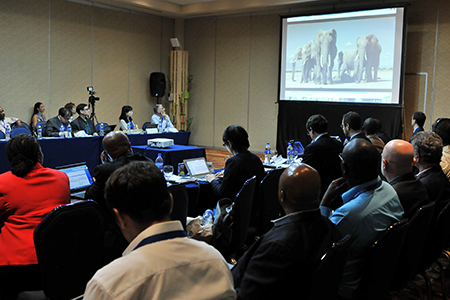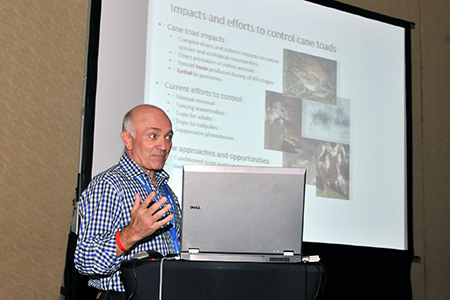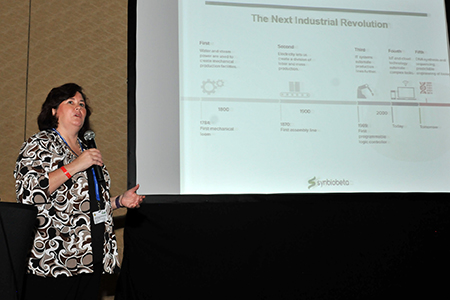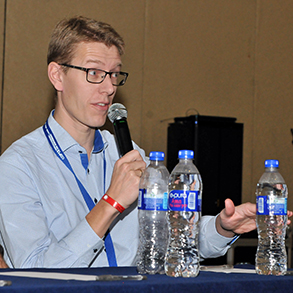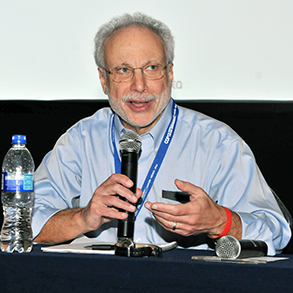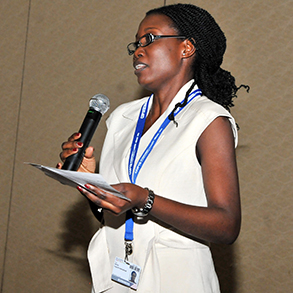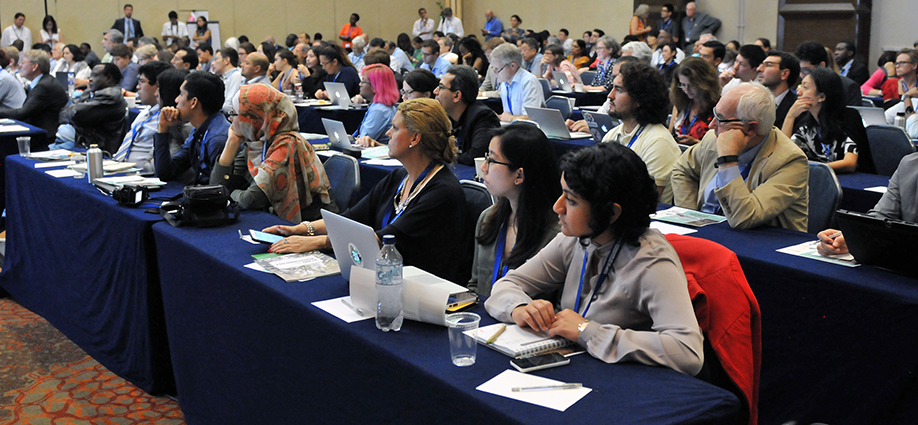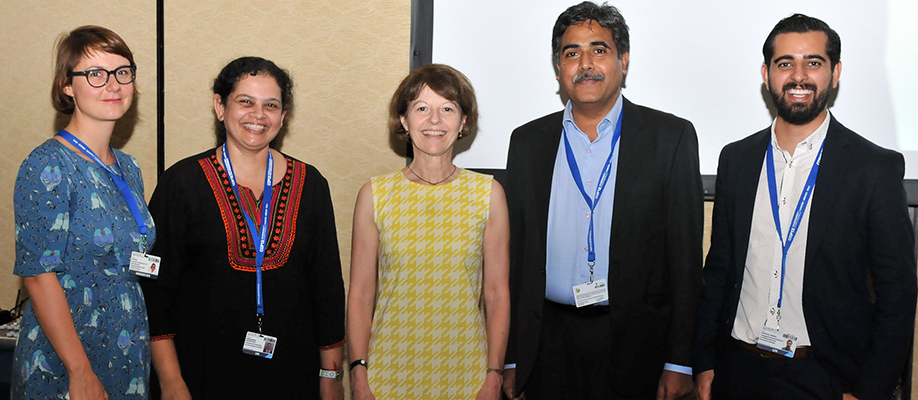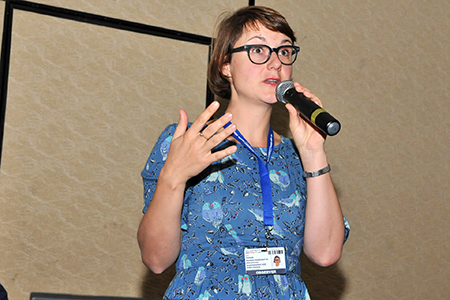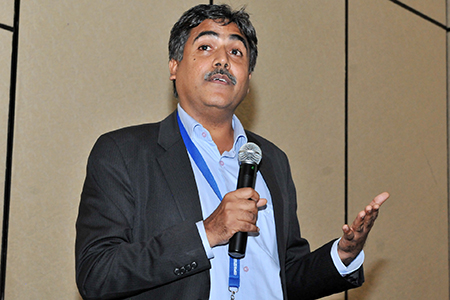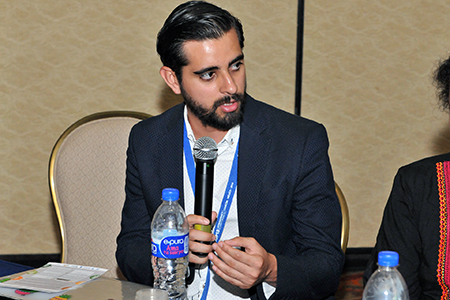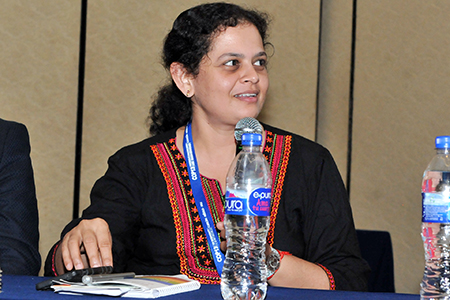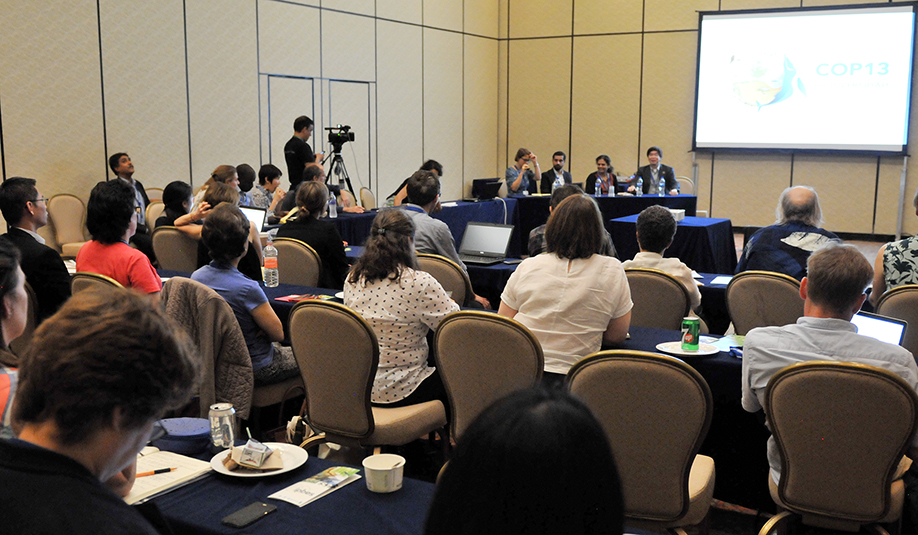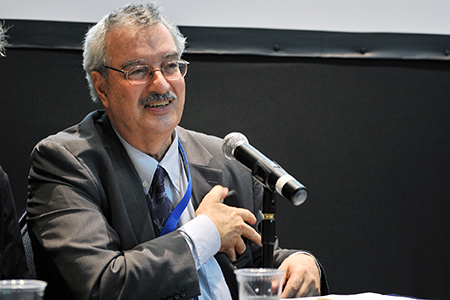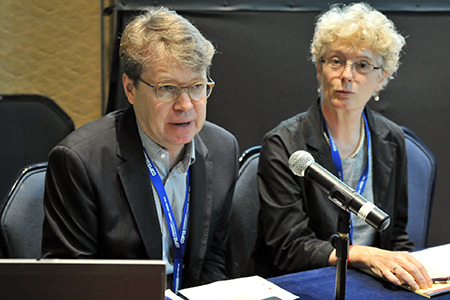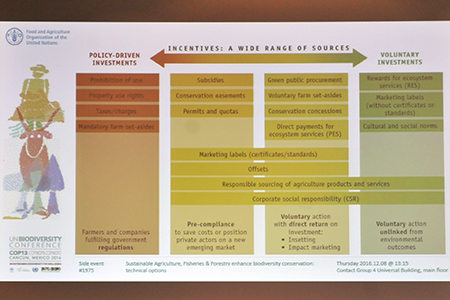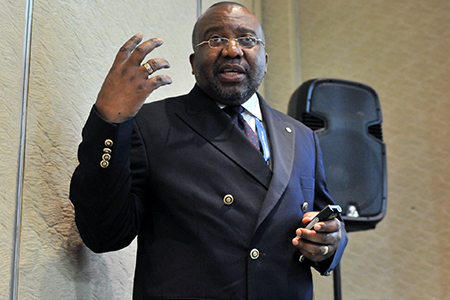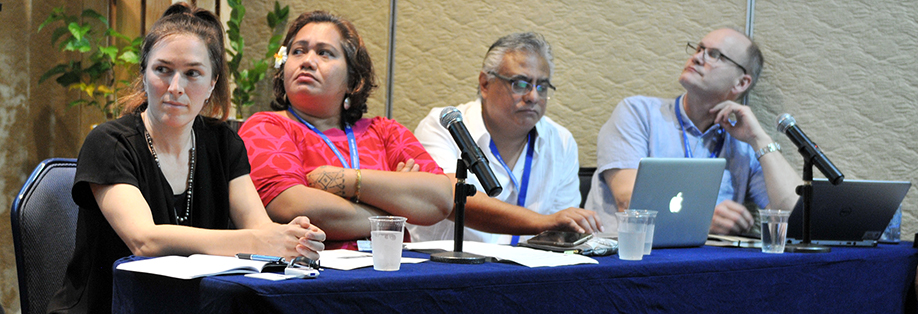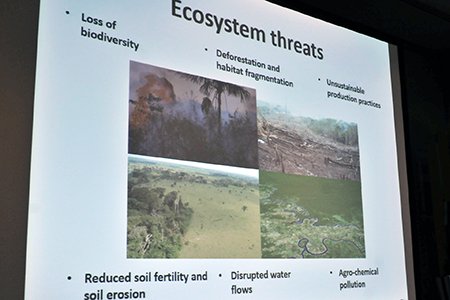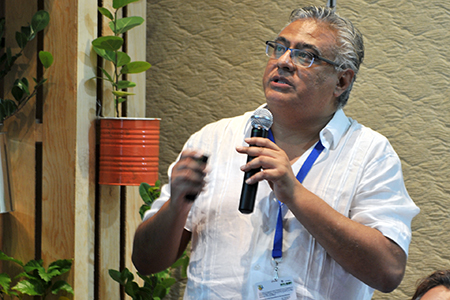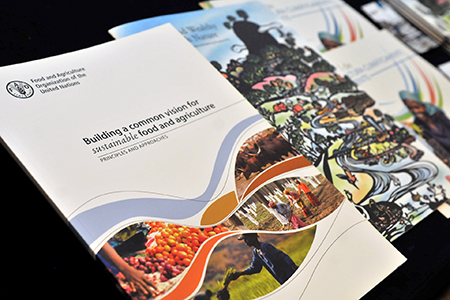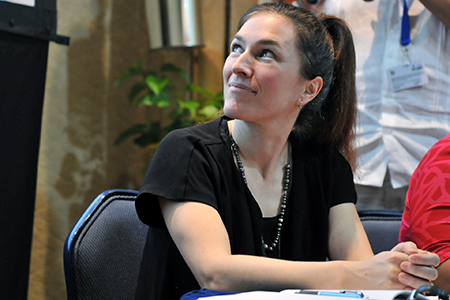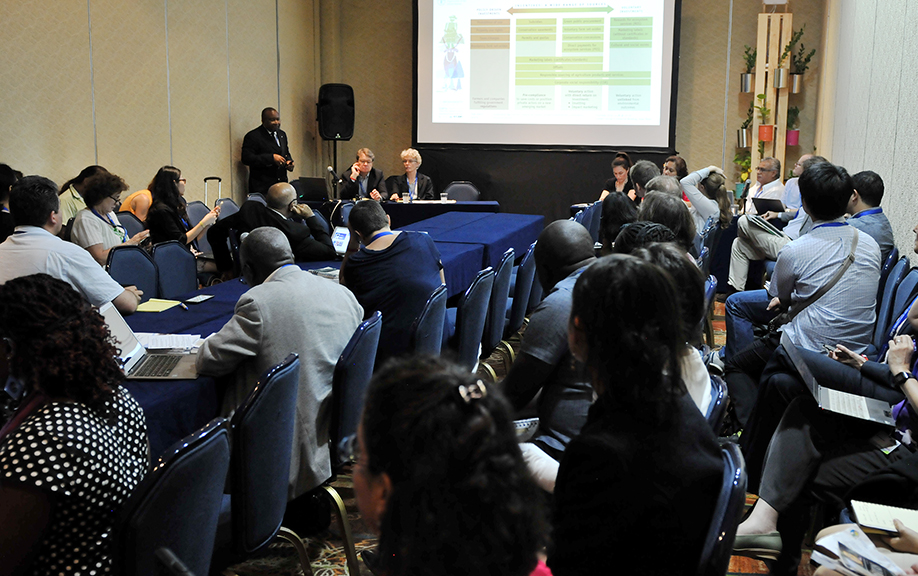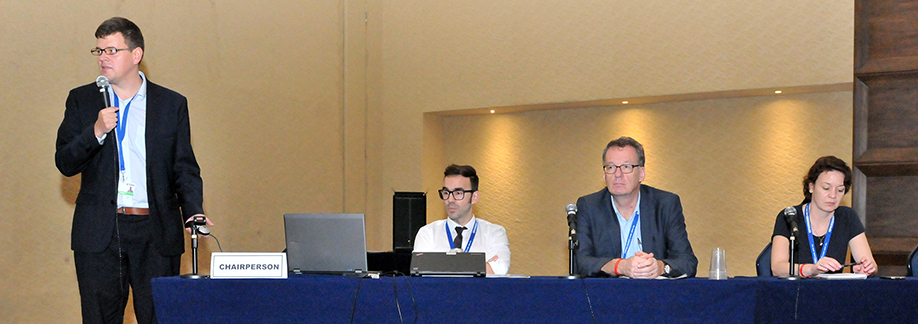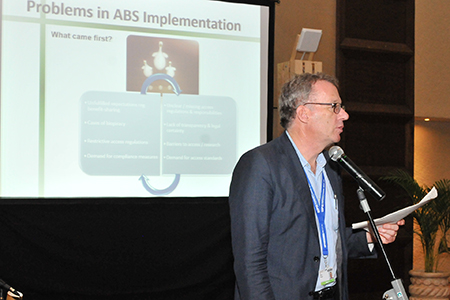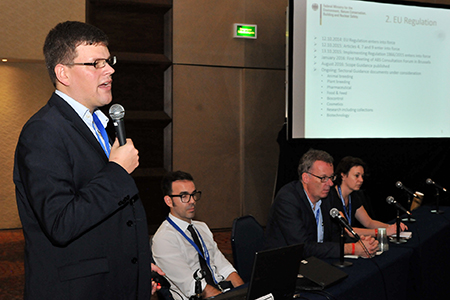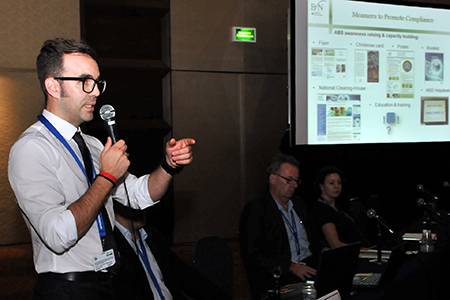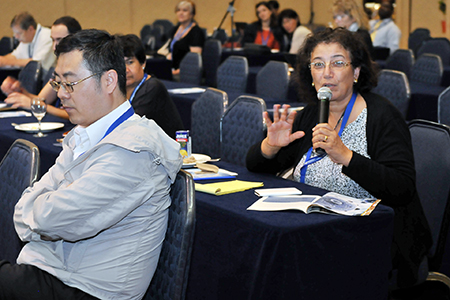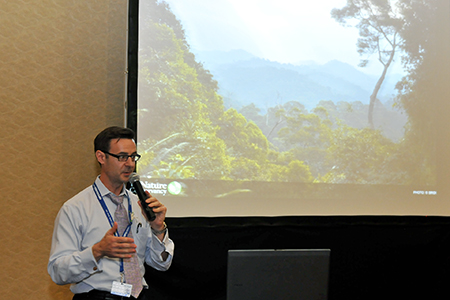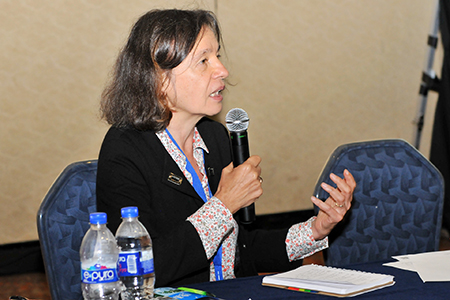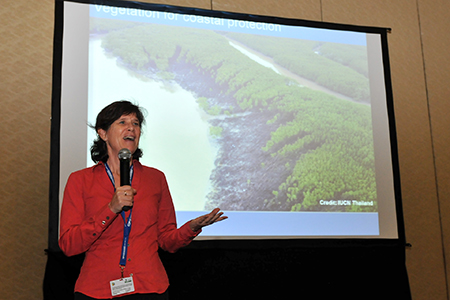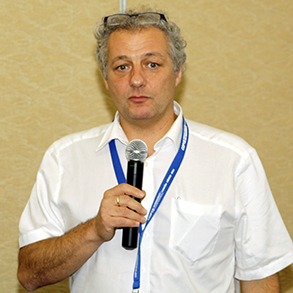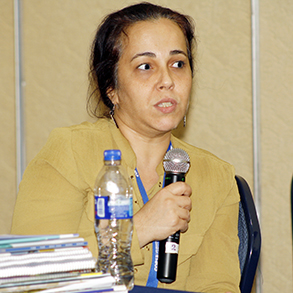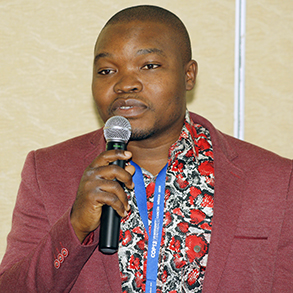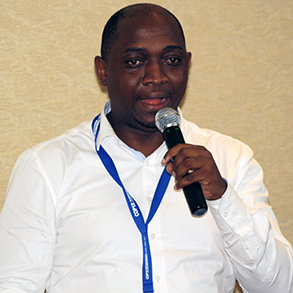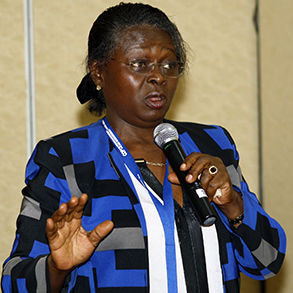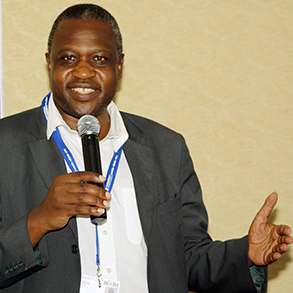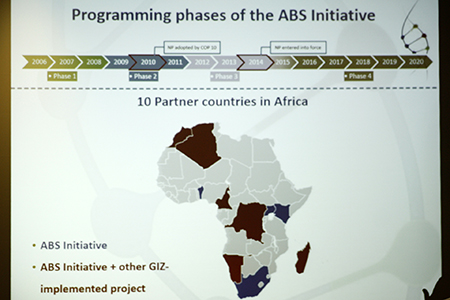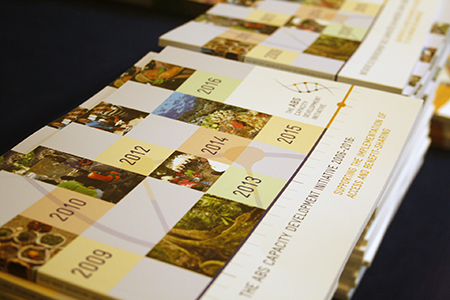Summary
The following events were covered by IISD Reporting Services on Thursday, 8 December 2016:
- GEF Investments and Donor Coordination to Address the Poaching and Illegal Wildlife Trade (IWT) Crisis
- Synthetic Biology — Opportunities, Challenges, and Environmental Benefits
- Multiple Approaches to Valuing Nature: The Work of the Intergovernmental Science-Policy Platform on Biodiversity and Ecosystem Services (IPBES) on Diverse Values and its Echo in Practice
- Sustainable Agriculture for Biodiversity: Taking Concrete Transformative Steps
- Operation Target 16 - Operationalization of the Nagoya Protocol on Access and Benefit Sharing (ABS) in Germany
- “Let Nature be the Solution”
- Insights in National Access and Benefit Sharing (ABS) Capacity Building Needs – Tools, Measures and (Regional) Approaches to Address Them
IISD Reporting Services, through its ENBOTS Meeting Coverage, is providing daily web coverage of selected side-events from the UN Biodiversity Conference.
Photos by IISD/ENB | Diego Noguera
For photo reprint permissions, please follow instructions at our Attribution Regulations for Meeting Photo Usage Page.
GEF Investments and Donor Coordination to Address the Poaching and Illegal Wildlife Trade (IWT) Crisis
Presented by the Global Environment Facility (GEF) and the World Bank
This event, moderated by Jaime Cavelier, GEF, presented the GEF-funded Global Partnership on Wildlife Conservation and Crime Prevention for Sustainable Development (the GPW project), which aims to tackle the poaching and the IWT crisis.
Mohamed Bakarr, GEF, said the GPW project follows GEF funding principles, including country-driven actions and partnerships. Cavelier presented an overview of the GPW project, highlighting components including: reducing poaching through enhancing wildlife benefits to communities; reducing IWT through increased law enforcement; and reducing demand for illegal wildlife products.
Elisson Wright, World Bank, presented a report analyzing international funding to tackle IWT. The report, he noted, maps out donor contributions from 24 bilateral agencies involving 1100 projects that tackled IWT in Africa and Asia between 2010 and 2016. He discussed: interventions in protected area management; promotion of sustainable use and alternative livelihoods; policy, research and assessment; and communication and awareness.
Matthias Krause, Federal Ministry for Economic Cooperation and Development (BMZ), Germany, reported on the ‘Wildlife Crime in Africa: from Crisis to Solution’ consultative meeting, held in June 2016 in Berlin, emphasizing that the magnitude of the IWT crisis requires international coordinated efforts. He reported German support of €800 million to support 400 protected areas.
Christine Dawson, US Department of State, said that, in 2010, the US contributed US$10 million towards IWT, which was up to US$95 million in 2015. She noted that an interministerial taskforce has been set up in the US involving 17 agencies, including the Departments of Justice and Defense, to address this issue from a crime perspective.
Kenichiro Tanaka, Ministry of Foreign Affairs, Japan, said as one of the largest donor of the GEF, his country is committed to continued work on IWT, including support for law enforcement particularly in customs.
Midori Paxton, UN Development Programme (UNDP), said her organization supports 13 national projects relating to IWT, including aspects of capacity building for enforcement, intelligence and landscape management with communities. She urged for long-term investment in sustaining successes in combatting IWT.
Johan Robinson, UN Environment, cited community projects providing incentives to prevent IWT and work with UNEP’s World Conservation Monitoring Centre (UNEP-WCMC) on issues regarding the Convention on International Trade in Endangered Species of Wild Fauna and Flora (CITES).
Presenting GWP project recipient country experiences, Hoang Thanh Nhan, Viet Nam Environment Administration, pointed out that tackling IWT requires involvement of all ministries and agencies, and not just those dealing with wildlife conservation. She noted an additional US$10 million from the US Agency for International Development to support the GWP project. She also reported on the Hanoi IWT conference held in November 2016 in Hanoi.
Agostinho Mangueze, National Administration for Conservation Areas (ANAC), Mozambique, demonstrated progress in addressing IWT, including: legislative changes to increase jail terms for wildlife crimes; regional collaboration with Tanzania and South Africa; capacity building of law enforcement; collaboration with Viet Nam to address supply chains; and community awareness.
Theresa Mundita Lim, Biodiversity Management Bureau, the Philippines, said that besides being a transit point for IWT, her country was also losing revenue amounting to US$ 230 million annually from IWT in marine biodiversity. She drew attention to the recently developed National Biodiversity Strategy and Action Plan that will enhance wildlife protection.
In ensuing discussions, participants noted the need to measure success of IWT interventions alongside funding trends. Nepal said whereas they have halted rhino poaching, tiger poaching is on the rise. Participants also noted the important role played by the media in reducing the value of ivory by almost half in China.
Mohamed Bakarr, GEF, said the GPW project has received US$131 million to date to combat IWT.
Jaime Cavelier, GEF, said the GPW project involves 19 countries for work on elephants, pangolins, rhino, gorilla and big cats and has leveraged an additional US$703 million.
Participants watched a WildAid video on the illegal wildlife trade.
Elisson Wright, World Bank, said the establishment of a donor engagement platform on IWT would allow proactive discussions and information sharing to enhance efforts in combatting IWT.
Partners of the GWP project
Contact:
- Jaime Cavelier (Coordinator)
| jcavelier@thegef.org - Elisson Wright (Coordinator)
| ewright1@worldbank.org
More Information:
Synthetic Biology — Opportunities, Challenges and Environmental Benefits
Presented by CropLife International (CLI)
This event, moderated by Taiwo Koyejo, CLI, addressed different applications of synthetic biology and how this technology should be regulated.
Henrik Toft Simonsen, Technological University of Denmark, noted different research aims of bioengineering, including: the production of chemicals, such as those used in drugs, vaccines, biofuels and vitamins, in a sustainable manner; novel use of engineered cells, such as through tissue engineering and diagnostics; and novel tools for engineering, such as “transformation tricks” and sequencing of DNA.
Robert Friedman, J. Craig Venter Institute, highlighted his Institute’s work on synthetic biology, and said the ongoing synthetic biology discussions at the thirteenth meeting of the Conference of the Parties to the Convention on Biological Diversity (CBD COP 13) contact group provide a good basis for risk assessment regarding living organisms developed through current and near-future applications of synthetic biology, noting such methodologies may need to be updated and adapted in the future.
Mark Tizard, Commonwealth Scientific and Industrial Research Organisation (CSIRO), distinguished between gene editing, genetic modification and gene drives, highlighting an opportunity, through gene editing to move from a “responsive” approach, typified by “slowness and luck,” to a “directed” approach, typified by “precision and speed.” On the possible release of gene drives, he called for: “a route with flashing lights, check points and off-ramps, rather than barricades.”
Kate Wildauer, SynBioBeta, highlighted potential positive impacts of synthetic biology, including: production of biodegradable forms of products such as plastics and inks, and conservation of plants and animals by providing alternatives to them. She said limiting the growth of synthetic biology tools with “disproportionate regulation” could have negative economic, ecological and security impacts, and called for supporting industry with appropriate regulation and governance that allows for safe outcomes.
In the discussion, participants considered, inter alia: ethical concerns, such as the loss of livelihoods in Africa due to the proliferation of synthetic biology; the risks of promoting synthetic biology versus the risks of banning it; dialogue as key to addressing the concerns of different groups; the need for adequate national biotechnology regulatory systems as the field progresses; the value of connecting early-phase start ups with regulatory agencies prior to commercialization; and the need for capacity building in the area of synthetic biology.
(L-R): Robert Friedman, J. Craig Venter Institute; Kate Wildauer, SynBioBeta; Mark Tizard, CSIRO; and Henrik Toft Simonsen, Technological University of Denmark
Mark Tizard, CSIRO, highlighted “the dynamic tension between conserving biodiversity and feeding the planet,” underscoring: “we are not in full control and new tools are urgently needed to help.”
Kate Wildauer, SynBioBeta, stressed that “synthetic biology is part of the next industrial revolution.”
Henrik Toft Simonsen, Technological University of Denmark, stated that over the next 40 years the world will need to build “a new Manhattan” every eight weeks due to increasing urbanization, and will need to do so in a different way from the past, noting bioengineering can assist.
Robert Friedman, J. Craig Venter Institute, noted his organization’s work on creating a “minimal cell” with the smallest set of genes necessary for growth, “to help us understand the fundamentals of life.”
Taiwo Koyejo, CLI, moderated the event.
A view of the room during the event
Contact:
- Taiwo Koyejo (Moderator)
| taiwo.koyejo@croplife.org
More Information:
Multiple Approaches to Valuing Nature: The Work of the Intergovernmental Science-Policy Platform on Biodiversity and Ecosystem Services (IPBES) on Diverse Values and its Echo in Practice
Presented by the UN University Institute for the Advanced Study of Sustainability (UNU-IAS), Deutsche Gesellschaft für Internationale Zusammenarbeit (GIZ) GmbH and IPBES
This side event, moderated by Ulrike Tröger, GIZ, presented the IPBES guide on multiple values of nature to support more holistic decision making and for incorporating these values into social and environmental assessments.
Anne Larigauderie, Executive Secretary, IPBES, spoke on the IPBES Work Programme 2014-2018 in providing scientific and methodological assessments for biodiversity and ecosystem services, and stressed the importance of considering plural or multiple values for nature to design appropriate methods which take these into account.
David González, National Autonomous University of Mexico, described a framework illustrating how to integrate different “ways of knowing and relating to nature” to encompass the diverse meanings of value. He compared the use of a single worldview for valuing nature, which often results in the use of cost-benefit analysis to measure economic value, with a plural perspective of worldviews for identifying the variety of policy instruments and governance systems that reflect diverse values for nature.
Suneetha Mazhenchery Subramanian, UNU-IAS, described a valuation methodology to strengthen access and benefit sharing (ABS) of biological resources in India. She noted that in order to go beyond economic valuation, it is necessary to consider the uncertainty of values, which varies according to the type of resource, ownership regime and sector involved. She stressed the need for mediation by competent authorities to ensure that the equity considerations of multiple actors are addressed, and the need to account for sectoral business models, uncertainty and the product life cycle for ABS.
Unnikrishnan Payyappallimana, UNU-IAS, described the work of the Regional Centres of Expertise (RCEs) in promoting education for sustainable development. He noted RCEs are innovative platforms for multisectoral and interdisciplinary information sharing and collaboration, which link formal education with networks and informal forms of learning, and, thus, provide added value in promoting multiple values for nature.
The ensuing discussions took place through a “fishbowl” style discussion in which panelists addressed topics raised by participants, such as, inter alia: the role of future generations in articulating values for nature; the challenge of accounting for “non-visible” values; raising political interest in identifying plural values for ecosystem services; and the need to consider continua and gradients in the assessment of ecosystem service values.
(L-R): Ulrike Tröger, GIZ; Suneetha Mazhenchery Subramanian, UNU-IAS; Anne Larigauderie, Executive Secretary, IPBES; Unnikrishnan Payyappallimana, UNU-IAS; and David González, National Autonomous University of Mexico
Ulrike Tröger, GIZ, described the ValuES Initiative, which provides an inventory of methods and instruments to assess and value ecosystem services.
Unnikrishnan Payyappallimana, UNU-IAS, described how RCEs promote “community-to-community” learning.
David González, National Autonomous University of Mexico, stressed that plural values for nature are needed to design management and policy interventions in a transparent manner.
Suneetha Mazhenchery Subramanian, UNU-IAS, stated that plural valuation for ABS need not focus only on economic values.
Participants during the discussion
Contact:
- Ulrike Tröger (Coordinator)
| ulrike.troeger@giz.de
More Information:
Sustainable Agriculture for Biodiversity: Taking Concrete Transformative Steps
Presented by the Food and Agriculture Organization of the UN (FAO)
This session was moderated by Dan Leskien, FAO. Braulio Ferreira de Souza Dias, Executive Secretary, Convention on Biological Diversity (CBD), highlighted the challenges facing agriculture including droughts and floods, and noted the need to adapt agriculture to new realities such as the impacts of climate change. He said that due to some unsustainable practices, agriculture is also a source of biodiversity loss and degradation, and called for robust actions to promote mainstreaming biodiversity into agriculture.
Chikelu Mba, Seeds and Plant Genetic Resources Team, FAO, called for a transition to a narrative that reflects the mutually reinforcing nature of agriculture and biodiversity. Noting that the focus has often been on the negative impacts of agriculture on biodiversity, he cited an example of agroforestry as a sustainable agricultural practice, which has the additional benefit of climate mitigation. He stressed the need to go beyond research on the positive impacts of agriculture, to making farmers embrace sustainable practices as part of their regular routines.
Rafael Obregón Viloria, National Commission for Knowledge and Sustainable Use of Biodiversity (CONABIO), Mexico, presented on innovations by the Mesoamerican Biological Corridor in Lacandon Tropical Forest, noting that the country began working on this multisectoral, participatory project to ensure that farmers continue to be stewards of nature by engaging in sustainable agricultural practices, diversifying their livelihoods, and conserving and restoring the landscapes around them. He stressed the importance of involving farmers, “respecting their value as producers,” and incentivizing them to voluntarily engage in biodiversity conservation.
Tauti Fautino M-Leota, Ministry of Natural Resources and Environment, Samoa, spoke on the overall policy framework facilitating the mainstreaming of biodiversity into national planning processes in her country, including the Strategy for the Development of Samoa, which considers the environment as a cross-cutting issue throughout. She pointed to the objectives of the environment sector, including governance, administering natural capital, and mainstreaming climate and disaster resilience, and noted the synergies between the agriculture and environment sectors.
Gunnstein Bakke, Directorate of Fisheries, Norway, presented on the ecosystems-based fisheries management in his country, noting the evolution of the sector from the 1970s when there was an overfishing crisis, to the current ecosystems-based system, which maintains both profitability of the fisheries sector as well as ecological sustainability. He stressed the need to maintain the adaptive capacity of the fisheries sector even after the recovery of fishstocks, including through the reduction of fishing vessels, and underscored the need for political will to ensure the sustainability of the sector.
Jeanine Volken, Federal Department of Economic Affairs, Switzerland, spoke on the role of agriculture in not only food production but also in the conservation of biodiversity. She drew attention to national agricultural policies, including the Proof of Ecological Performance tool to ensure sustainable agricultural practices.
Moderating the discussion, Kim Friedman, FAO, noted the need to strengthen mainstreaming efforts already underway, underscoring the need to include both farmers and consumers in these efforts. Participants and panelists then considered, inter alia: the need for community engagement to promote the achievement of the Aichi Biodiversity Targets; the role of markets in creating more sustainable fishing patterns; and the need for national-level institutional frameworks to successfully implement the Sustainable Development Goals (SDGs).
(L-R): Chikelu Mba, Seeds and Plant Genetic Resources Team, FAO; Dan Leskien, FAO; Irene Hoffmann, Commission on Genetic Resources for Food and Agriculture, FAO; and Braulio Ferreira de Souza Dias, Executive Secretary, CBD
Braulio Ferreira de Souza Dias, Executive Secretary, CBD, noted “huge opportunities” for win-win solutions between the agriculture and environment sectors.
Dan Leskien and Irene Hoffmann, FAO
A slide from Chikelu Mba’s presentation
Chikelu Mba, Seeds and Plant Genetic Resources Team, FAO, called for packaging solutions tailored to farmers and providing the financial and technical solutions to incentivize them to move towards sustainable practices.
(L-R): Jeanine Volken, Federal Department of Economic Affairs, Switzerland; Tauti Fautino M-Leota, Ministry of Natural Resources and Environment, Samoa; Rafael Obregón Viloria, National Commission for Knowledge and Sustainable Use of Biodiversity (CONABIO), Mexico; and Gunnstein Bakke, Directorate of Fisheries, Norway
A slide from the presentation of Rafael Obregón Viloria
Rafael Obregón Viloria, CONABIO, Mexico, noted the country’s promotion of local and regional agricultural value chains.
Jeanine Volken, Federal Department of Economic Affairs, Switzerland
A view of the room during the side event
Contact:
- Chikelu Mba (Coordinator)
| Chikelu.Mba@fao.org
More Information:
Operation Target 16 - Operationalization of the Nagoya Protocol on Access and Benefit Sharing (ABS) in Germany
Presented by the German Federal Ministry for the Environment, Nature Conservation, Building and Nuclear Safety (BMUB), and the German Federal Agency for Nature Conservation (BfN)
This side event, moderated by Stefan Lütkes, BMUB, provided an overview of the steps undertaken by Germany to operationalize the Nagoya Protocol in order to achieve Aichi Biodiversity Target 16 (on ABS).
Lütkes cited the German Act Implementing the Obligations under the Nagoya Protocol and Transposing Regulation of July 2016, noting that Germany is taking its obligations under the Nagoya Protocol very seriously. He elaborated on the relationship between BMUB as the Protocol’s national focal point and BfN, the competent national authority for the Protocol.
Thomas Ebben, BMUB, presented a case study on the practical and legal aspects of implementing the Protocol in Germany. He said four institutions have national experience in ABS: BfN; the Federal Agency for Agriculture and Food; Robert-Koch-Institut; and the German Patent and Trade Mark Office. BfN, he noted, is the “one-stop-shop,” providing users with services, such as information, advice, declarations, checks and sanctions in regards to ABS issues.
Thomas Greiber, BfN, said the role of his institution includes: processing and verifying criteria for applications for inclusion in the EU register of collections; checking user compliance; enforcing compliance and sanctioning infringements; and providing information and advice. He demonstrated the ABS Clearing-House Mechanism and highlighted some challenges, including constraints in identifying risk criteria for compliance checks.
In discussions, participants asked for clarification on how BfN deals with confidentiality and assures adequate checkpoints. Panelists noted that confidentiality of information requires clarity on why this should be private, and noted two control point stages during declaration of due diligence. Participants were also informed that the EU regulates compliance measures but that ABS is under the sovereignty of individual member states.
(L-R): Thomas Ebben, BMUB; Thomas Greiber, BfN; Stefan Lütkes, BMUB; and Ellen Frederichs, BfN
Stefan Lütkes, BMUB, moderated the event, discussing the legal framework for implementing the Nagoya Protocol on ABS in Germany.
Thomas Ebben, BfN, discussed the role of his institution in promoting and monitoring compliance and enforcement and demonstrated submissions of due diligence through the EU-developed online DECLARE platform.
Thomas Greiber, BfN, discussed the role of his institution in promoting and monitoring compliance and enforcement and demonstrated submissions of due diligence through the EU developed online DECLARE platform.
A participant asks a question during the discussion.
Contact:
- Thomas Greiber (Coordinator)
| thomas.greiber@bfn.de - Thomas Ebben (Coordinator)
| thomas.ebben@bmub.bund.de
More Information:
“Let Nature be the Solution”
Presented by the European Commission (EC)
This event, moderated by Marco Fritz, EC, and Barbara Livoreil, Foundation for Biodiversity Research, France, discussed “Nature-Based Solutions” (NBS) which provide business opportunities for regenerating urban areas, improving air and water quality, -and disaster risk reduction (DRR).
Andrew Deutz, The Nature Conservancy (TNC), highlighted the investment opportunities that exist in reframing nature as infrastructure, stressing that nature improves water and air quality and is the first line of defense in protecting coastal developments from disasters. He also identified the role of NBS in regenerating cities, offering insurance values in the face of hydrological risks, and for climate mitigation.
Sarah Bekessy, Royal Melbourne Institute of Technology (RMIT), highlighted the critical role of “everyday nature” for the future of urban development, emphasizing its role in, inter alia: mitigating and adapting to climate change; “re-enchanting” people with nature; providing health benefits for adults and children. She also emphasized opportunities to connect urban dwellers with indigenous knowledge through urban greening projects.
Karen Sudmeier-Rieux, IUCN Commission on Ecosystem Management, spoke about the role of NBS for DRR. She stressed that ecosystems can: prevent or mitigate hazards; reduce exposure by functioning as natural buffers; and reduce vulnerability by supporting livelihoods before, during and after disasters strike. She noted that a key challenge for incorporating biodiversity and ecosystems into DRR lies in convincing engineers and finance ministries to compare the costs and benefits of “grey” versus “green” infrastructure.
Ángela Andrade, IUCN Commission on Ecosystem Management, summarized lessons learned from the event, noting that NBS is a “problem-oriented approach” that addresses the key challenges facing urban areas by enhancing flood protection, food security, climate mitigation and the health of urban populations. She underlined the importance of showcasing the social, cultural and economic benefits of NBS, as well as the need to adopt a collaborative approach across different sectors, including for agriculture, mining and engineering.
In the ensuing discussion, participants discussed the potential of NBS to rejuvenate the most industrialized areas within urban settings.
Andrew Deutz, TNC, said that people tend to think of nature as a “victim in the face of infrastructure development,” but that “we need to think of nature as part of the solution.”
Sarah Bekessy, RMIT, stressed that we must shift thinking from biodiversity as an urban constraint to a massive opportunity for sustainable urban development.
Ángela Andrade, IUCN Commission on Ecosystem Management, stressed that a “big opportunity” exists to change people’s perceptions about development as being synonymous with ecosystem restoration.
Karen Sudmeier-Rieux, IUCN Committee on Ecosystem Management, highlighted the multiple benefits of ecosystem approaches to DRR.
A view of the room during the event
Contact:
- Marco Fritz (Coordinator)
| marco.fritz@ec.europa.eu
More Information:
Insights in National Access and Benefit Sharing (ABS) Capacity-Building Needs – Tools, Measures and (Regional) Approaches to Address Them
Presented by the ABS Capacity Development Initiative (ABS Initiative)
This event, moderated by Andreas Drews, Deutsche Gesellschaft für Internationale Zusammenarbeit GmbH (GIZ), saw representatives of the ABS Initiative and several African partner countries present and discuss progress made, success factors and challenges.
Drews introduced the multi-donor ABS Initiative, noting its work in Africa, the Caribbean and the Pacific. He said the Initiative’s core activities in its 10 African partner countries comprise support for: national capacity building, focusing on national institutional regulatory ABS frameworks; ensuring effective participation of Indigenous Peoples and Local Communities (IPLCs); and the development of ABS agreements.
Melle Assia Azzi, Algeria, highlighted ABS activities in her country, including: contribution to the analysis o=f the national legal framework; an inception workshop of the Algerian ABS policy and legal framework project; capacity building of national focal points and stakeholders; and a national diagnostic study. She said work on IPLCs may commence in 2017.
Kavaka Watai Mukonyi, Kenya, highlighted activities including: institutional approaches for improved coordination on ABS permits and decisions; legal gap analysis; training; support to three pilot community-based ABS projects; studies on genetic resources and traditional knowledge (TK) utilization; and dialogue between the private sector and providers.
Albun William Banye Lemnyuy, Cameroon, noted, inter alia: the drafting of a national ABS strategy; support for development of an interim ABS regulation; and negotiation of, support for, and comments on, various mutually agreed terms (MATs). Prudence Galega, Cameroon, additionally highlighted her country’s intent to develop a law, rather than an interim regulation, on ABS by April 2017.
Naritiana Rakotoniaina Ranaivoson, Madagascar, highlighted: a “political letter” on ABS, which provides an overall ABS strategy; development of an interim ABS regulation; clarification of the involvement of local communities in the prior informed consent procedure process; the establishment of a biodiversity community register; and the piloting of valorization activities.
Hugues Adeloui Akpona, Benin, noted activities in his country include: popularization of the national ABS strategy; support to the development of an interim ABS regulation; a pilot bio-cultural community protocol project; preparatory consultations on a TK documentation strategy; creating the basis for a valorization strategy; and capacity building to make existing partnerships ABS compliant.
Opening the discussion, Suhel al-Janabi, ABS Initiative, called for input from speakers on lessons learned. Speakers expressed an interest in learning from other countries: about experiences of developing ABS laws and signing MATs; how to get “a good deal” within an agreement; how to put in place a fair benefit-sharing mechanism; how to ensure monetary benefits reach communities; and how to identify who represents communities. They also expressed an interest in sharing research.
In closing, Mahlet Teshome Kebede, African Union, reflected on the potential for regional or continental implementation.
Suhel al-Janabi, ABS Initiative, highlighted very different capacity building and support needs in different countries.
Melle Assia Azzi, Algeria, noted that “sometimes it is easy to adopt a law, but difficult to implement it in the field.”
Hugues Adeloui Akpona, Benin, noted ongoing efforts to clarify the representation of local communities at the national level.
Albun William Banye Lemnyuy, Cameroon, offered to share experiences on MAT negotiation and signature.
Prudence Galega, Cameroon, highlighted training parliamentarians who work with communities as an important entry point for training on IPLCs.
Kavaka Watui Mukonyi, Kenya, stressed effective ABS laws are a driver for research and development, which is key for the economy.
Contact:
- Andreas Drews (Coordinator)
| andreas.drews@giz.de



